Data Science Report on Collin's Car Parking System Analysis
VerifiedAdded on 2024/06/03
|15
|1863
|353
Report
AI Summary
This report provides a detailed analysis of Collin's car parking system, which accommodates both ordinary and fixed customers. It includes various diagrams such as use case diagrams, sequence diagrams, and class diagrams to illustrate the system's functionality and interactions. The report discusses subsystems for ordinary customers who pay each time, fixed customers who pay in advance, and security management, detailing their respective use cases and sequence flows. The class diagram outlines the attributes, methods, and classes necessary for the system's development. Through these diagrams and descriptions, the report offers a comprehensive understanding of the car parking system's design and operation, highlighting the interactions between different actors and system components. Desklib provides this document along with a wealth of other study resources for students.
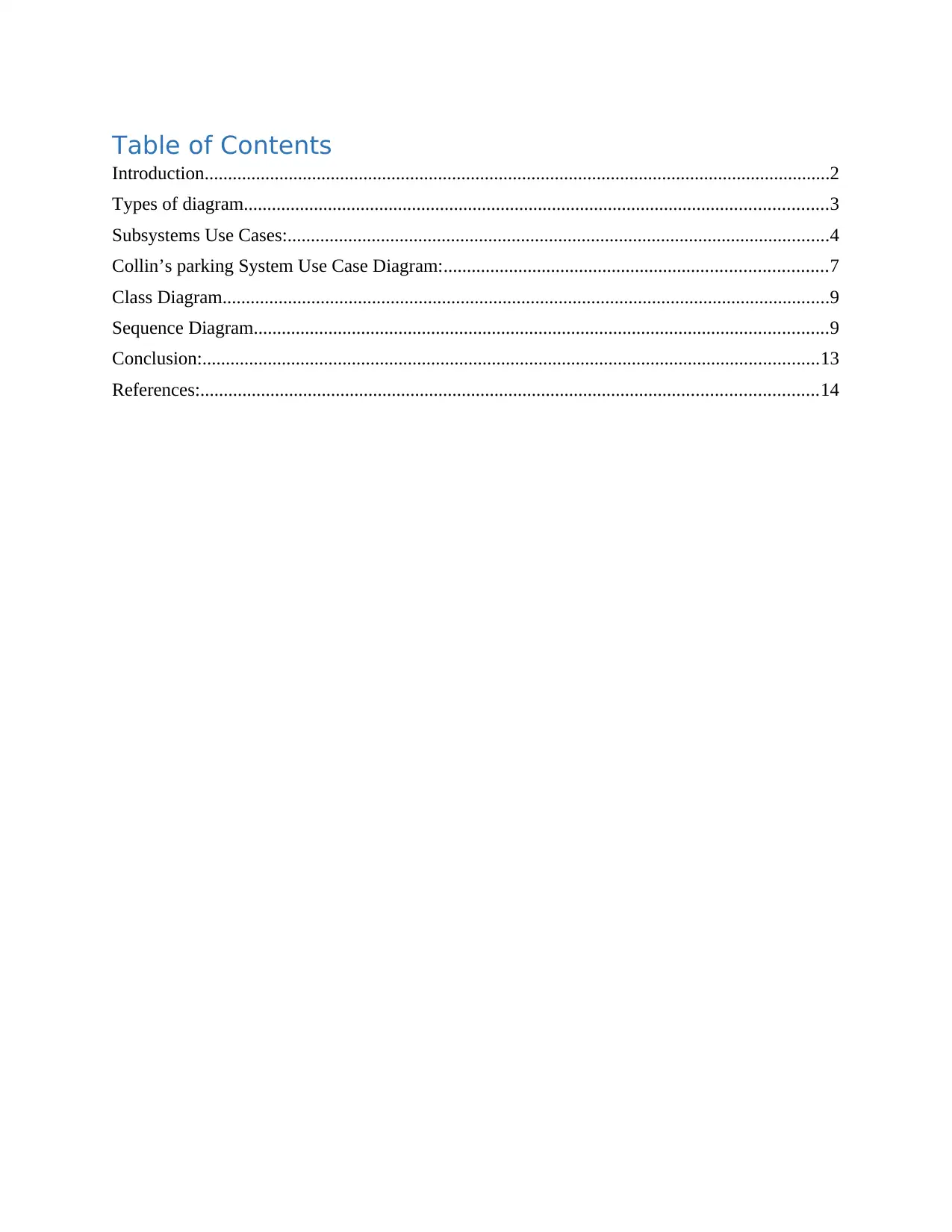
Table of Contents
Introduction......................................................................................................................................2
Types of diagram.............................................................................................................................3
Subsystems Use Cases:....................................................................................................................4
Collin’s parking System Use Case Diagram:..................................................................................7
Class Diagram..................................................................................................................................9
Sequence Diagram...........................................................................................................................9
Conclusion:....................................................................................................................................13
References:....................................................................................................................................14
Introduction......................................................................................................................................2
Types of diagram.............................................................................................................................3
Subsystems Use Cases:....................................................................................................................4
Collin’s parking System Use Case Diagram:..................................................................................7
Class Diagram..................................................................................................................................9
Sequence Diagram...........................................................................................................................9
Conclusion:....................................................................................................................................13
References:....................................................................................................................................14
Paraphrase This Document
Need a fresh take? Get an instant paraphrase of this document with our AI Paraphraser
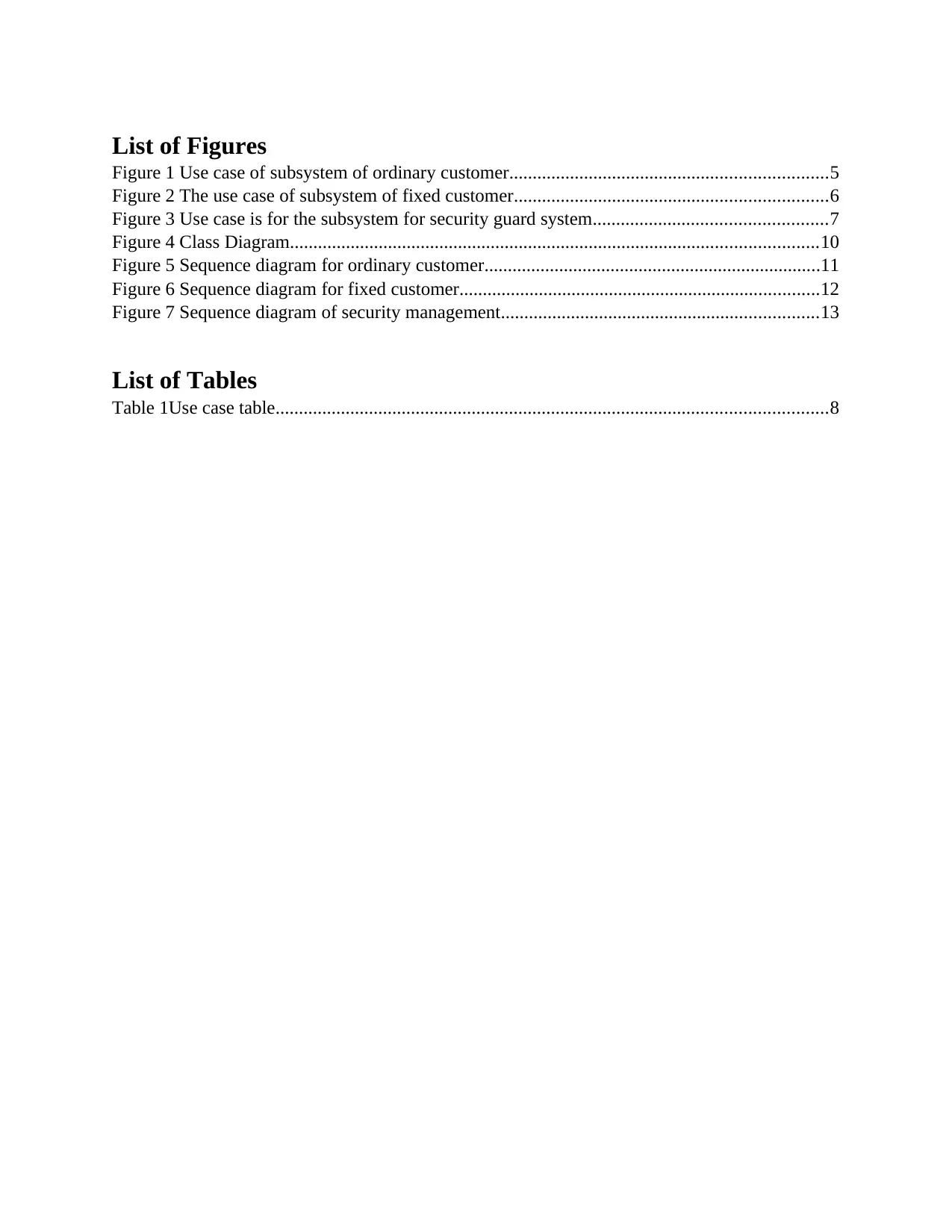
List of Figures
Figure 1 Use case of subsystem of ordinary customer....................................................................5
Figure 2 The use case of subsystem of fixed customer...................................................................6
Figure 3 Use case is for the subsystem for security guard system..................................................7
Figure 4 Class Diagram.................................................................................................................10
Figure 5 Sequence diagram for ordinary customer........................................................................11
Figure 6 Sequence diagram for fixed customer.............................................................................12
Figure 7 Sequence diagram of security management....................................................................13
List of Tables
Table 1Use case table......................................................................................................................8
Figure 1 Use case of subsystem of ordinary customer....................................................................5
Figure 2 The use case of subsystem of fixed customer...................................................................6
Figure 3 Use case is for the subsystem for security guard system..................................................7
Figure 4 Class Diagram.................................................................................................................10
Figure 5 Sequence diagram for ordinary customer........................................................................11
Figure 6 Sequence diagram for fixed customer.............................................................................12
Figure 7 Sequence diagram of security management....................................................................13
List of Tables
Table 1Use case table......................................................................................................................8
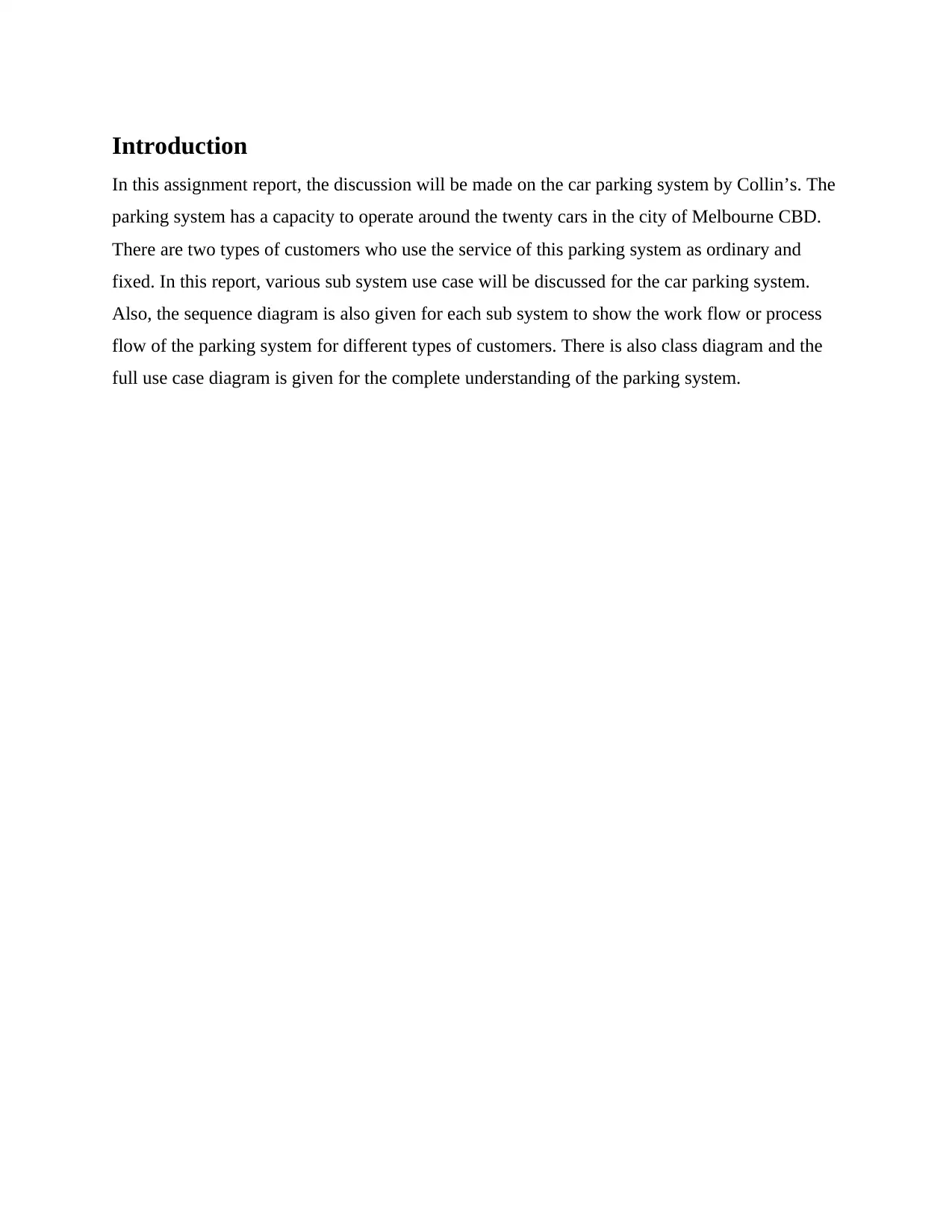
Introduction
In this assignment report, the discussion will be made on the car parking system by Collin’s. The
parking system has a capacity to operate around the twenty cars in the city of Melbourne CBD.
There are two types of customers who use the service of this parking system as ordinary and
fixed. In this report, various sub system use case will be discussed for the car parking system.
Also, the sequence diagram is also given for each sub system to show the work flow or process
flow of the parking system for different types of customers. There is also class diagram and the
full use case diagram is given for the complete understanding of the parking system.
In this assignment report, the discussion will be made on the car parking system by Collin’s. The
parking system has a capacity to operate around the twenty cars in the city of Melbourne CBD.
There are two types of customers who use the service of this parking system as ordinary and
fixed. In this report, various sub system use case will be discussed for the car parking system.
Also, the sequence diagram is also given for each sub system to show the work flow or process
flow of the parking system for different types of customers. There is also class diagram and the
full use case diagram is given for the complete understanding of the parking system.
⊘ This is a preview!⊘
Do you want full access?
Subscribe today to unlock all pages.

Trusted by 1+ million students worldwide
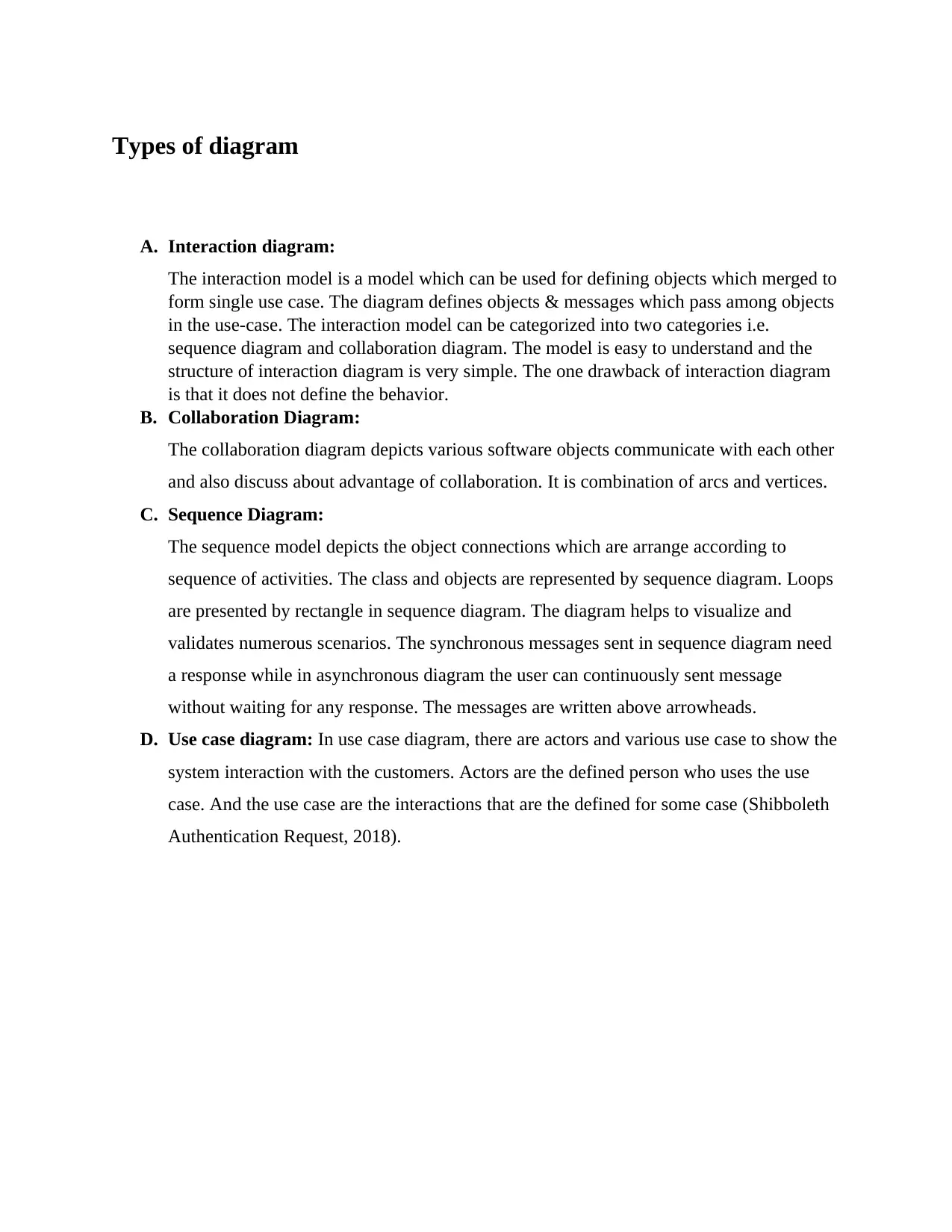
Types of diagram
A. Interaction diagram:
The interaction model is a model which can be used for defining objects which merged to
form single use case. The diagram defines objects & messages which pass among objects
in the use-case. The interaction model can be categorized into two categories i.e.
sequence diagram and collaboration diagram. The model is easy to understand and the
structure of interaction diagram is very simple. The one drawback of interaction diagram
is that it does not define the behavior.
B. Collaboration Diagram:
The collaboration diagram depicts various software objects communicate with each other
and also discuss about advantage of collaboration. It is combination of arcs and vertices.
C. Sequence Diagram:
The sequence model depicts the object connections which are arrange according to
sequence of activities. The class and objects are represented by sequence diagram. Loops
are presented by rectangle in sequence diagram. The diagram helps to visualize and
validates numerous scenarios. The synchronous messages sent in sequence diagram need
a response while in asynchronous diagram the user can continuously sent message
without waiting for any response. The messages are written above arrowheads.
D. Use case diagram: In use case diagram, there are actors and various use case to show the
system interaction with the customers. Actors are the defined person who uses the use
case. And the use case are the interactions that are the defined for some case (Shibboleth
Authentication Request, 2018).
A. Interaction diagram:
The interaction model is a model which can be used for defining objects which merged to
form single use case. The diagram defines objects & messages which pass among objects
in the use-case. The interaction model can be categorized into two categories i.e.
sequence diagram and collaboration diagram. The model is easy to understand and the
structure of interaction diagram is very simple. The one drawback of interaction diagram
is that it does not define the behavior.
B. Collaboration Diagram:
The collaboration diagram depicts various software objects communicate with each other
and also discuss about advantage of collaboration. It is combination of arcs and vertices.
C. Sequence Diagram:
The sequence model depicts the object connections which are arrange according to
sequence of activities. The class and objects are represented by sequence diagram. Loops
are presented by rectangle in sequence diagram. The diagram helps to visualize and
validates numerous scenarios. The synchronous messages sent in sequence diagram need
a response while in asynchronous diagram the user can continuously sent message
without waiting for any response. The messages are written above arrowheads.
D. Use case diagram: In use case diagram, there are actors and various use case to show the
system interaction with the customers. Actors are the defined person who uses the use
case. And the use case are the interactions that are the defined for some case (Shibboleth
Authentication Request, 2018).
Paraphrase This Document
Need a fresh take? Get an instant paraphrase of this document with our AI Paraphraser
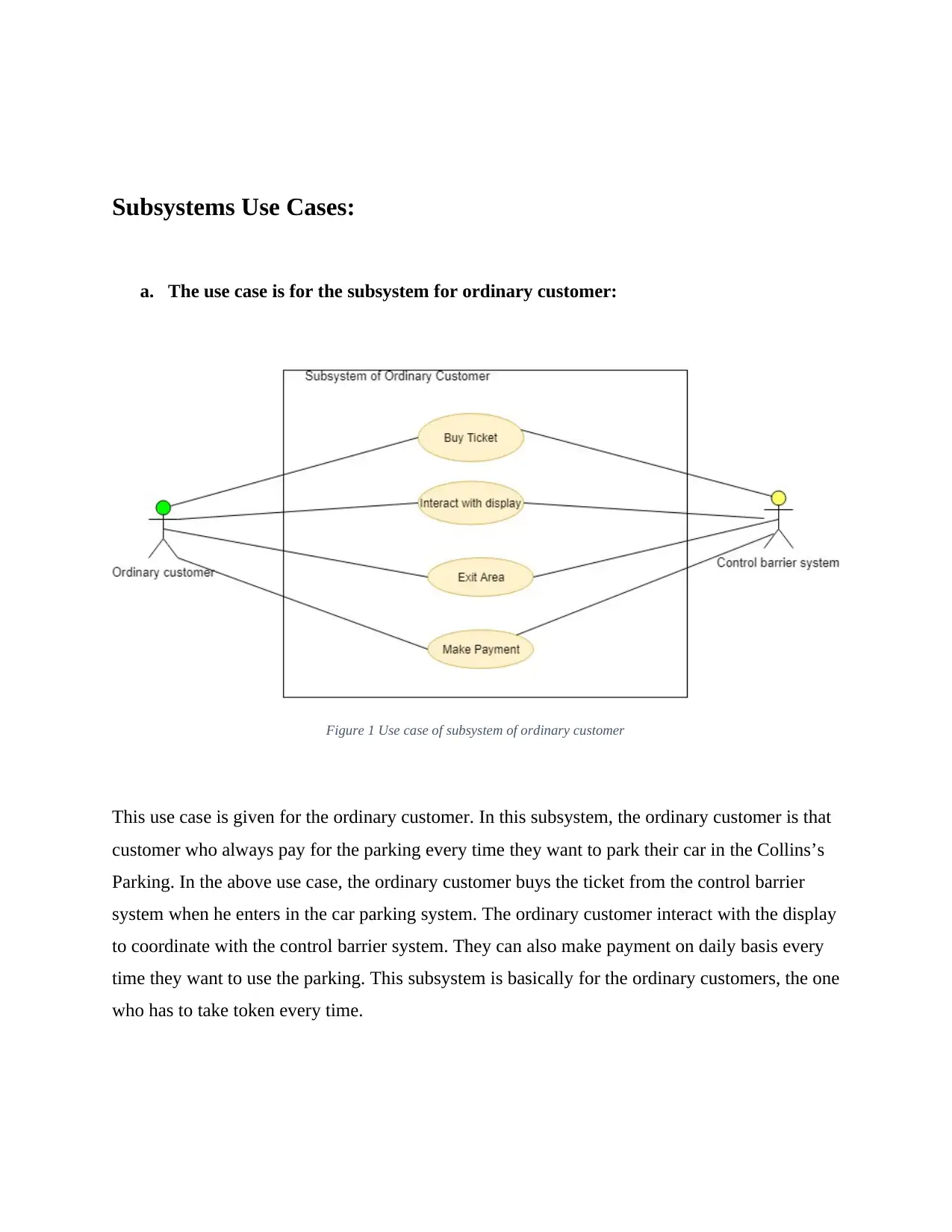
Subsystems Use Cases:
a. The use case is for the subsystem for ordinary customer:
Figure 1 Use case of subsystem of ordinary customer
This use case is given for the ordinary customer. In this subsystem, the ordinary customer is that
customer who always pay for the parking every time they want to park their car in the Collins’s
Parking. In the above use case, the ordinary customer buys the ticket from the control barrier
system when he enters in the car parking system. The ordinary customer interact with the display
to coordinate with the control barrier system. They can also make payment on daily basis every
time they want to use the parking. This subsystem is basically for the ordinary customers, the one
who has to take token every time.
a. The use case is for the subsystem for ordinary customer:
Figure 1 Use case of subsystem of ordinary customer
This use case is given for the ordinary customer. In this subsystem, the ordinary customer is that
customer who always pay for the parking every time they want to park their car in the Collins’s
Parking. In the above use case, the ordinary customer buys the ticket from the control barrier
system when he enters in the car parking system. The ordinary customer interact with the display
to coordinate with the control barrier system. They can also make payment on daily basis every
time they want to use the parking. This subsystem is basically for the ordinary customers, the one
who has to take token every time.
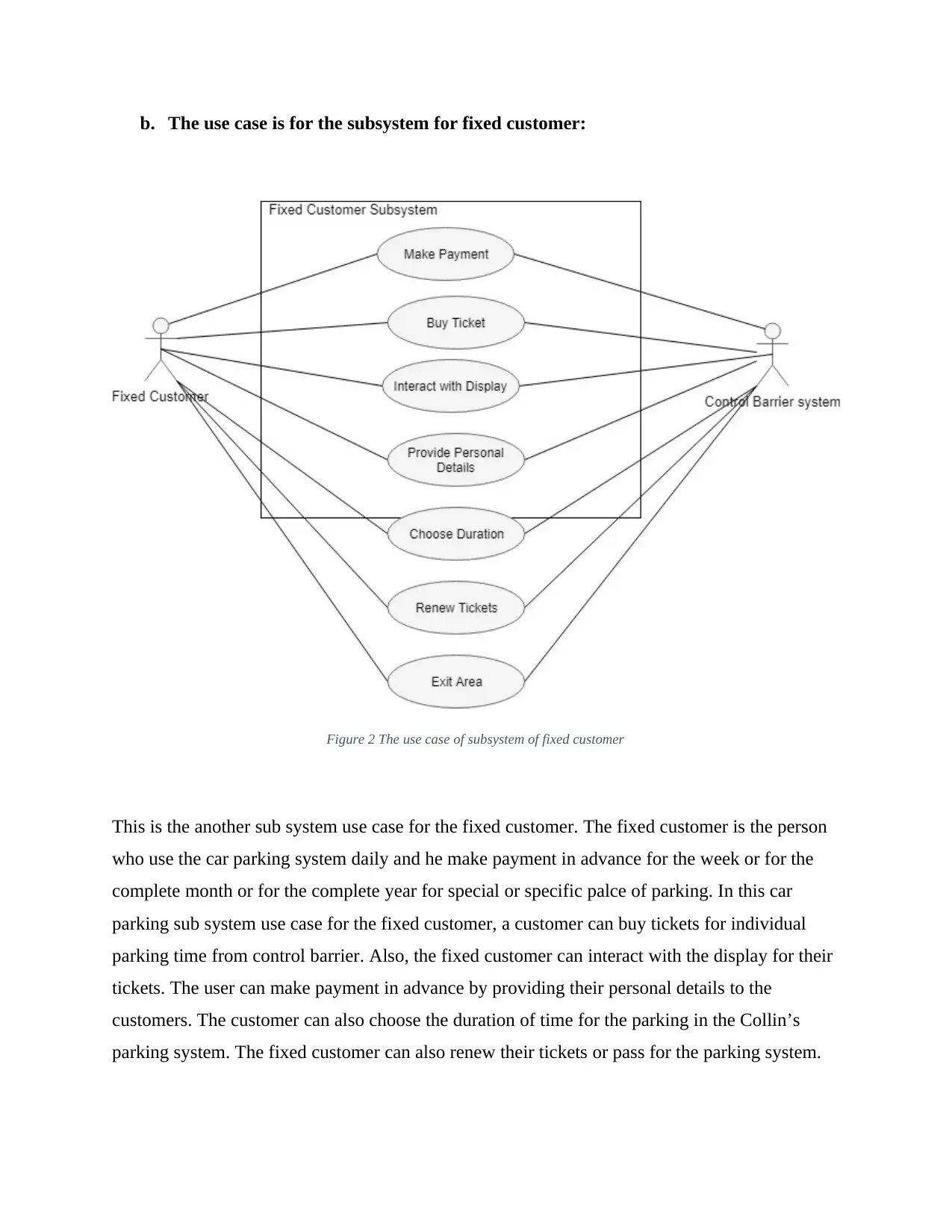
b. The use case is for the subsystem for fixed customer:
Figure 2 The use case of subsystem of fixed customer
This is the another sub system use case for the fixed customer. The fixed customer is the person
who use the car parking system daily and he make payment in advance for the week or for the
complete month or for the complete year for special or specific palce of parking. In this car
parking sub system use case for the fixed customer, a customer can buy tickets for individual
parking time from control barrier. Also, the fixed customer can interact with the display for their
tickets. The user can make payment in advance by providing their personal details to the
customers. The customer can also choose the duration of time for the parking in the Collin’s
parking system. The fixed customer can also renew their tickets or pass for the parking system.
Figure 2 The use case of subsystem of fixed customer
This is the another sub system use case for the fixed customer. The fixed customer is the person
who use the car parking system daily and he make payment in advance for the week or for the
complete month or for the complete year for special or specific palce of parking. In this car
parking sub system use case for the fixed customer, a customer can buy tickets for individual
parking time from control barrier. Also, the fixed customer can interact with the display for their
tickets. The user can make payment in advance by providing their personal details to the
customers. The customer can also choose the duration of time for the parking in the Collin’s
parking system. The fixed customer can also renew their tickets or pass for the parking system.
⊘ This is a preview!⊘
Do you want full access?
Subscribe today to unlock all pages.

Trusted by 1+ million students worldwide
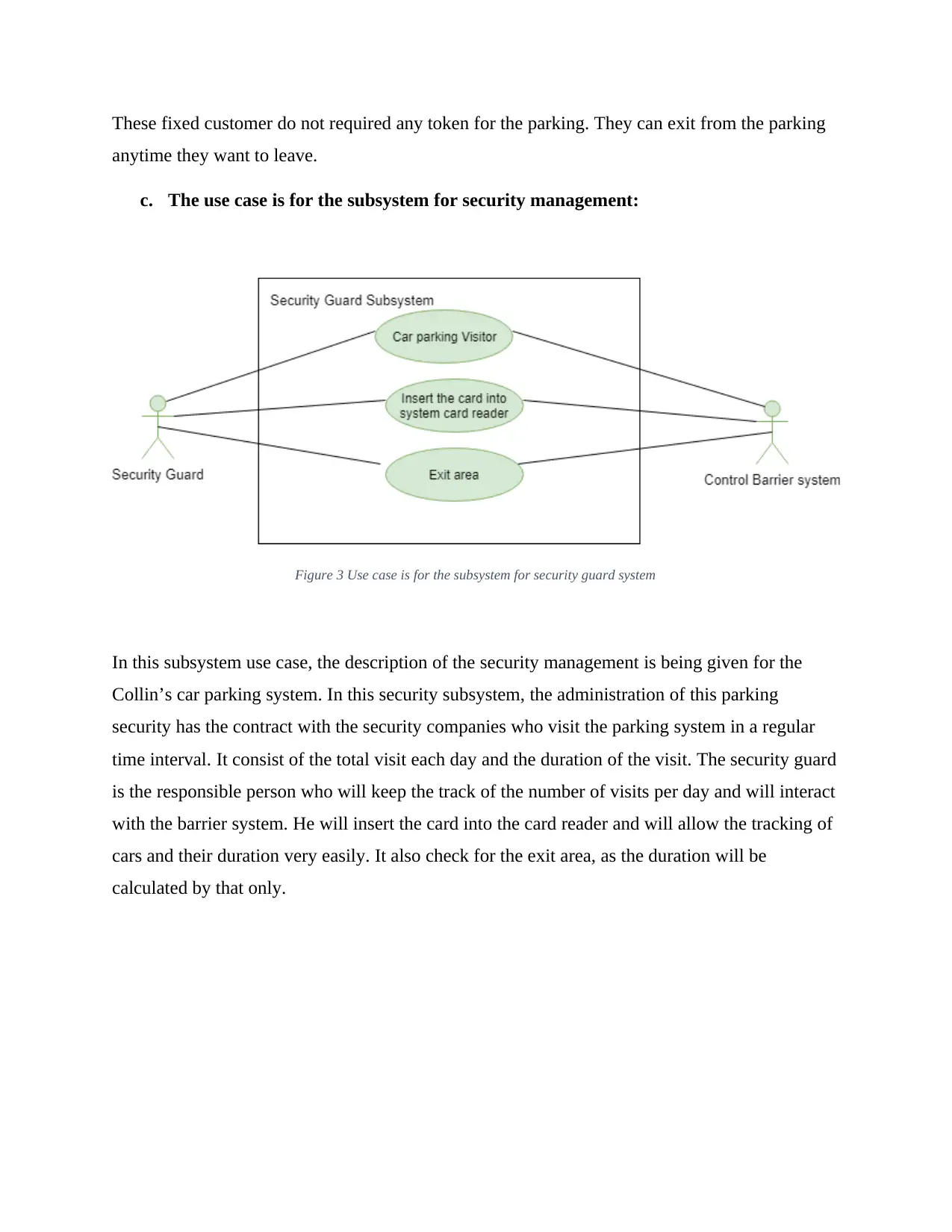
These fixed customer do not required any token for the parking. They can exit from the parking
anytime they want to leave.
c. The use case is for the subsystem for security management:
Figure 3 Use case is for the subsystem for security guard system
In this subsystem use case, the description of the security management is being given for the
Collin’s car parking system. In this security subsystem, the administration of this parking
security has the contract with the security companies who visit the parking system in a regular
time interval. It consist of the total visit each day and the duration of the visit. The security guard
is the responsible person who will keep the track of the number of visits per day and will interact
with the barrier system. He will insert the card into the card reader and will allow the tracking of
cars and their duration very easily. It also check for the exit area, as the duration will be
calculated by that only.
anytime they want to leave.
c. The use case is for the subsystem for security management:
Figure 3 Use case is for the subsystem for security guard system
In this subsystem use case, the description of the security management is being given for the
Collin’s car parking system. In this security subsystem, the administration of this parking
security has the contract with the security companies who visit the parking system in a regular
time interval. It consist of the total visit each day and the duration of the visit. The security guard
is the responsible person who will keep the track of the number of visits per day and will interact
with the barrier system. He will insert the card into the card reader and will allow the tracking of
cars and their duration very easily. It also check for the exit area, as the duration will be
calculated by that only.
Paraphrase This Document
Need a fresh take? Get an instant paraphrase of this document with our AI Paraphraser
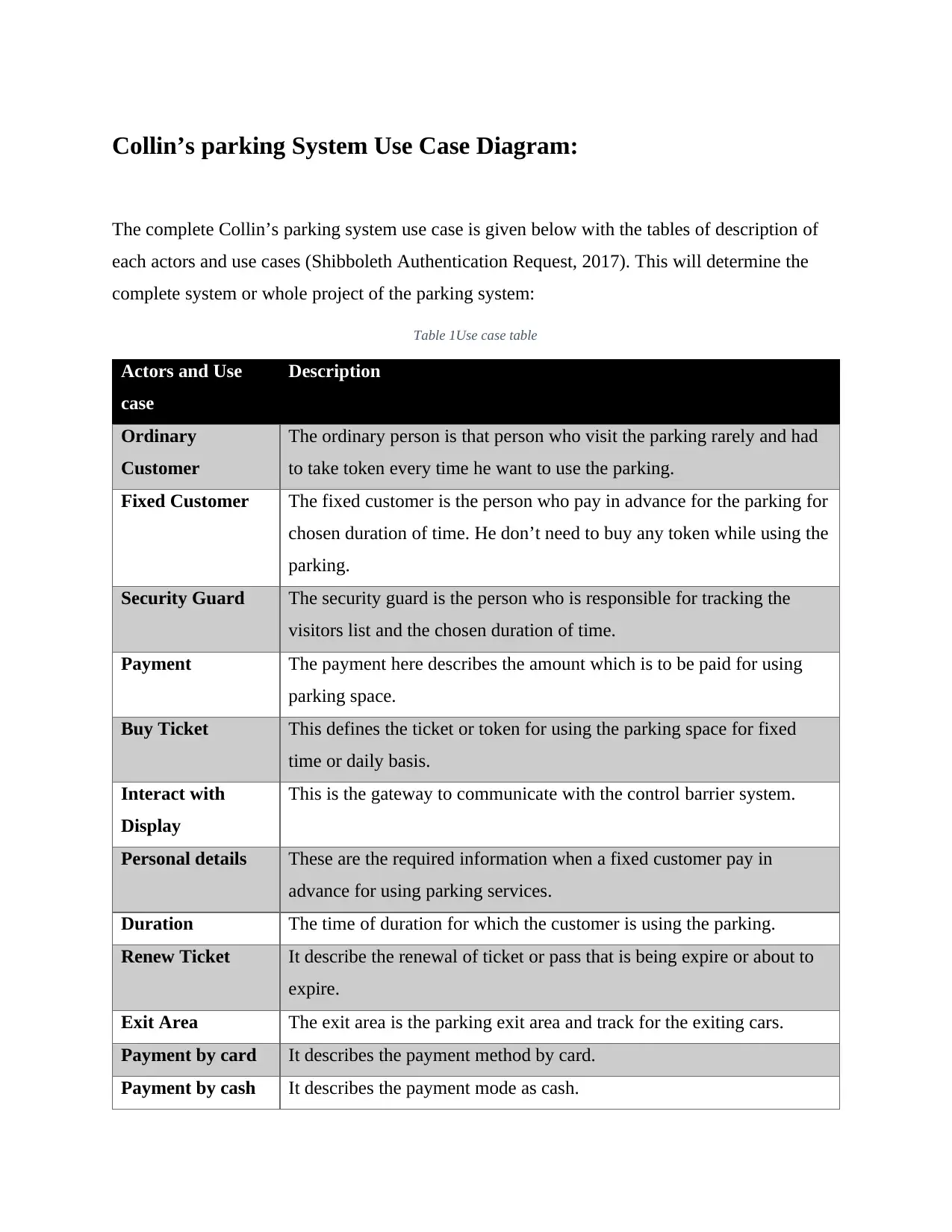
Collin’s parking System Use Case Diagram:
The complete Collin’s parking system use case is given below with the tables of description of
each actors and use cases (Shibboleth Authentication Request, 2017). This will determine the
complete system or whole project of the parking system:
Table 1Use case table
Actors and Use
case
Description
Ordinary
Customer
The ordinary person is that person who visit the parking rarely and had
to take token every time he want to use the parking.
Fixed Customer The fixed customer is the person who pay in advance for the parking for
chosen duration of time. He don’t need to buy any token while using the
parking.
Security Guard The security guard is the person who is responsible for tracking the
visitors list and the chosen duration of time.
Payment The payment here describes the amount which is to be paid for using
parking space.
Buy Ticket This defines the ticket or token for using the parking space for fixed
time or daily basis.
Interact with
Display
This is the gateway to communicate with the control barrier system.
Personal details These are the required information when a fixed customer pay in
advance for using parking services.
Duration The time of duration for which the customer is using the parking.
Renew Ticket It describe the renewal of ticket or pass that is being expire or about to
expire.
Exit Area The exit area is the parking exit area and track for the exiting cars.
Payment by card It describes the payment method by card.
Payment by cash It describes the payment mode as cash.
The complete Collin’s parking system use case is given below with the tables of description of
each actors and use cases (Shibboleth Authentication Request, 2017). This will determine the
complete system or whole project of the parking system:
Table 1Use case table
Actors and Use
case
Description
Ordinary
Customer
The ordinary person is that person who visit the parking rarely and had
to take token every time he want to use the parking.
Fixed Customer The fixed customer is the person who pay in advance for the parking for
chosen duration of time. He don’t need to buy any token while using the
parking.
Security Guard The security guard is the person who is responsible for tracking the
visitors list and the chosen duration of time.
Payment The payment here describes the amount which is to be paid for using
parking space.
Buy Ticket This defines the ticket or token for using the parking space for fixed
time or daily basis.
Interact with
Display
This is the gateway to communicate with the control barrier system.
Personal details These are the required information when a fixed customer pay in
advance for using parking services.
Duration The time of duration for which the customer is using the parking.
Renew Ticket It describe the renewal of ticket or pass that is being expire or about to
expire.
Exit Area The exit area is the parking exit area and track for the exiting cars.
Payment by card It describes the payment method by card.
Payment by cash It describes the payment mode as cash.
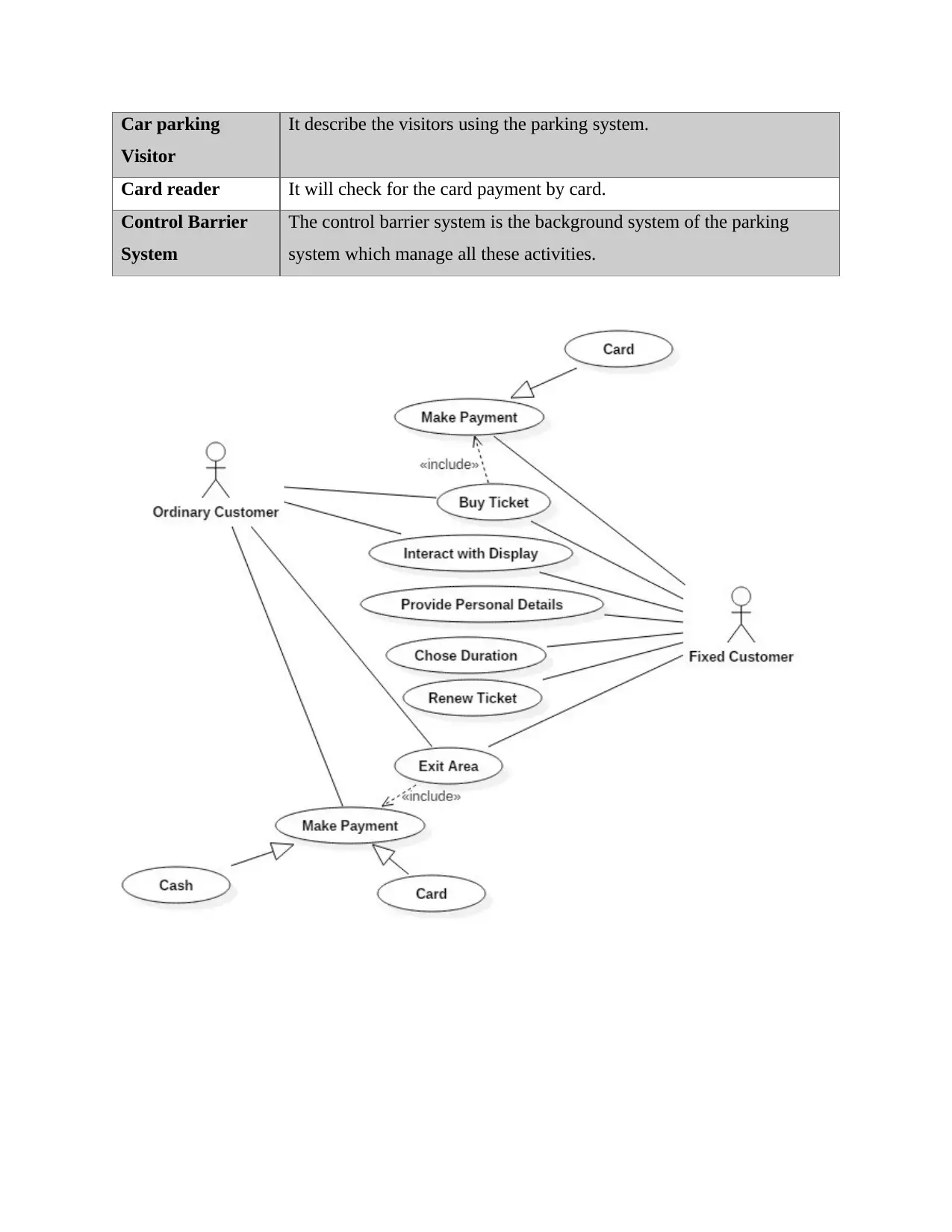
Car parking
Visitor
It describe the visitors using the parking system.
Card reader It will check for the card payment by card.
Control Barrier
System
The control barrier system is the background system of the parking
system which manage all these activities.
Visitor
It describe the visitors using the parking system.
Card reader It will check for the card payment by card.
Control Barrier
System
The control barrier system is the background system of the parking
system which manage all these activities.
⊘ This is a preview!⊘
Do you want full access?
Subscribe today to unlock all pages.

Trusted by 1+ million students worldwide
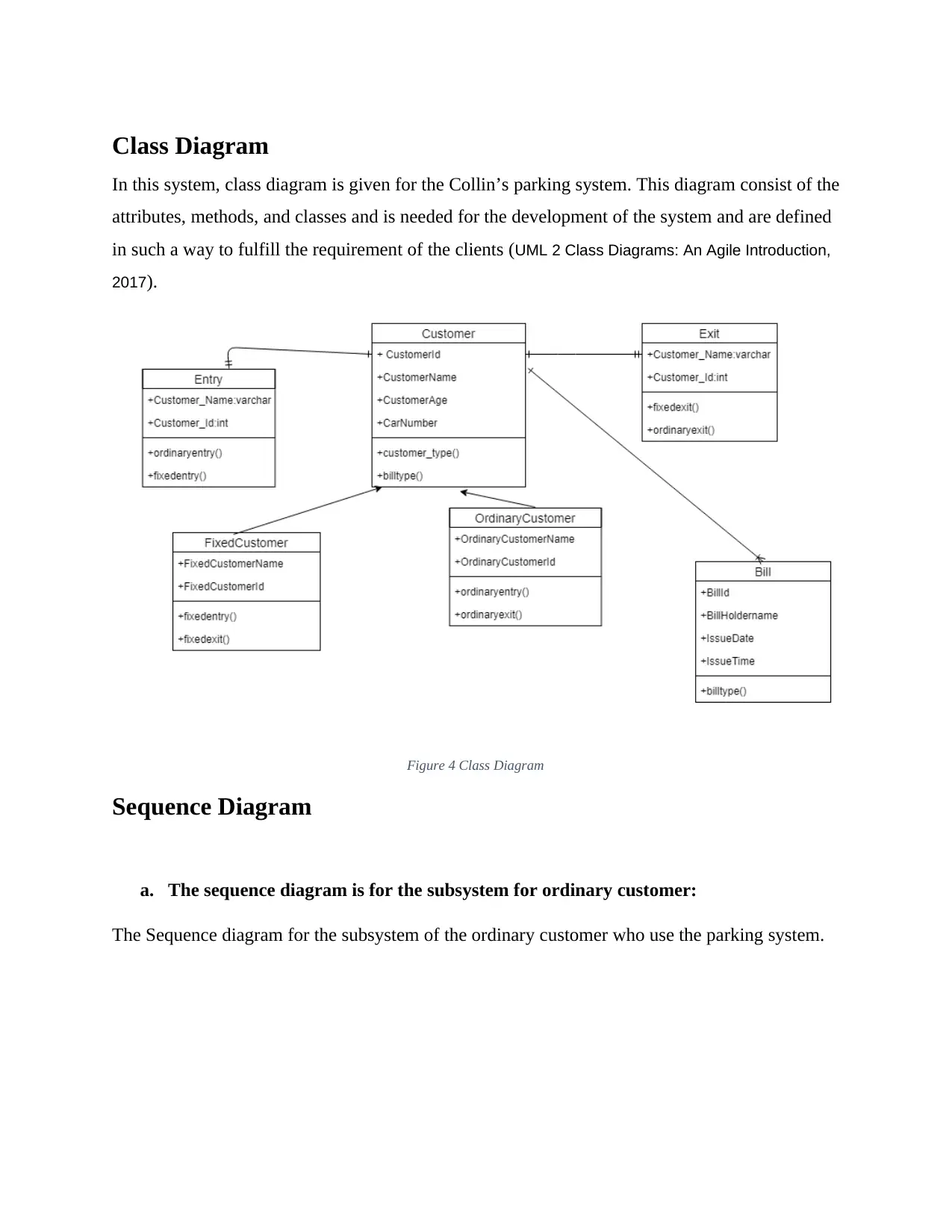
Class Diagram
In this system, class diagram is given for the Collin’s parking system. This diagram consist of the
attributes, methods, and classes and is needed for the development of the system and are defined
in such a way to fulfill the requirement of the clients (UML 2 Class Diagrams: An Agile Introduction,
2017).
Figure 4 Class Diagram
Sequence Diagram
a. The sequence diagram is for the subsystem for ordinary customer:
The Sequence diagram for the subsystem of the ordinary customer who use the parking system.
In this system, class diagram is given for the Collin’s parking system. This diagram consist of the
attributes, methods, and classes and is needed for the development of the system and are defined
in such a way to fulfill the requirement of the clients (UML 2 Class Diagrams: An Agile Introduction,
2017).
Figure 4 Class Diagram
Sequence Diagram
a. The sequence diagram is for the subsystem for ordinary customer:
The Sequence diagram for the subsystem of the ordinary customer who use the parking system.
Paraphrase This Document
Need a fresh take? Get an instant paraphrase of this document with our AI Paraphraser
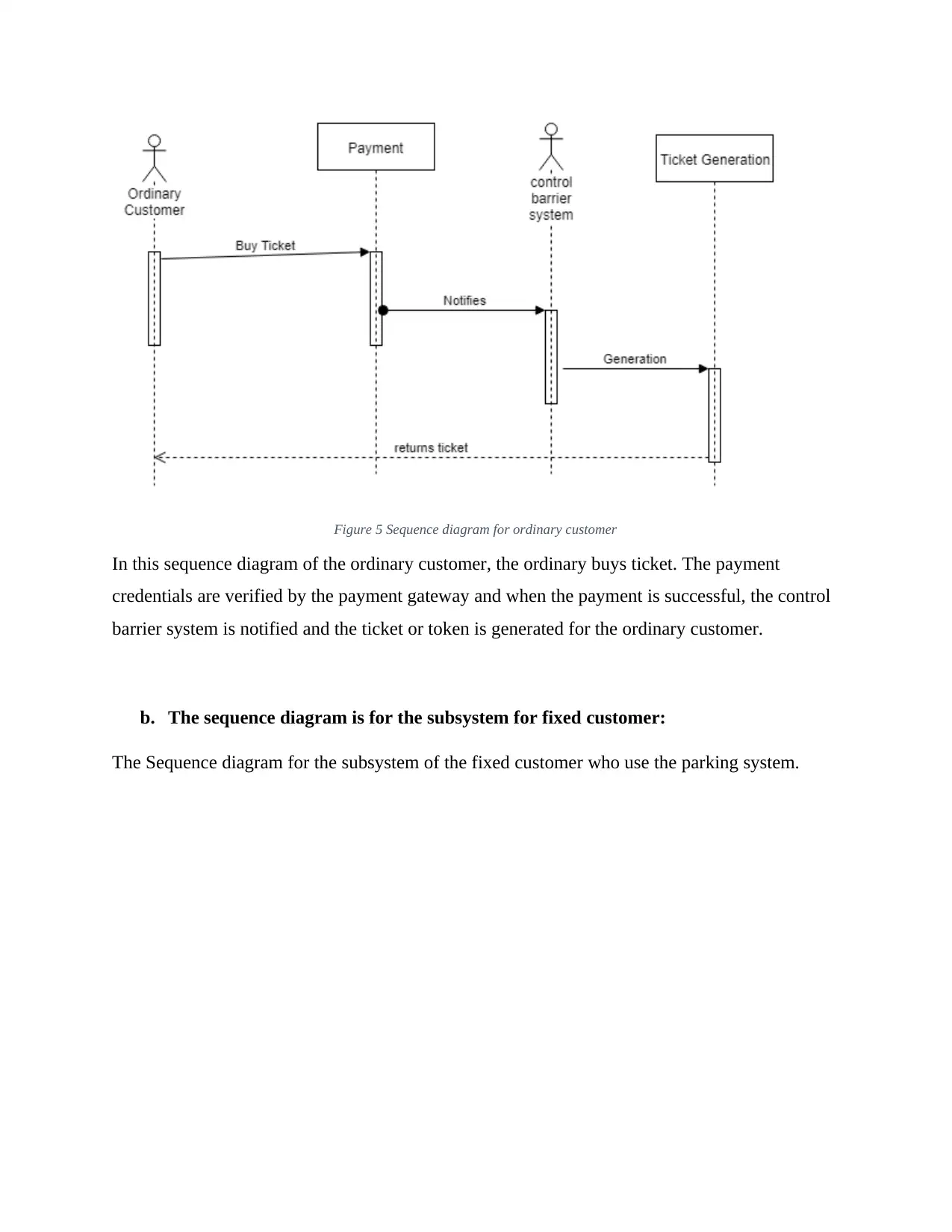
Figure 5 Sequence diagram for ordinary customer
In this sequence diagram of the ordinary customer, the ordinary buys ticket. The payment
credentials are verified by the payment gateway and when the payment is successful, the control
barrier system is notified and the ticket or token is generated for the ordinary customer.
b. The sequence diagram is for the subsystem for fixed customer:
The Sequence diagram for the subsystem of the fixed customer who use the parking system.
In this sequence diagram of the ordinary customer, the ordinary buys ticket. The payment
credentials are verified by the payment gateway and when the payment is successful, the control
barrier system is notified and the ticket or token is generated for the ordinary customer.
b. The sequence diagram is for the subsystem for fixed customer:
The Sequence diagram for the subsystem of the fixed customer who use the parking system.
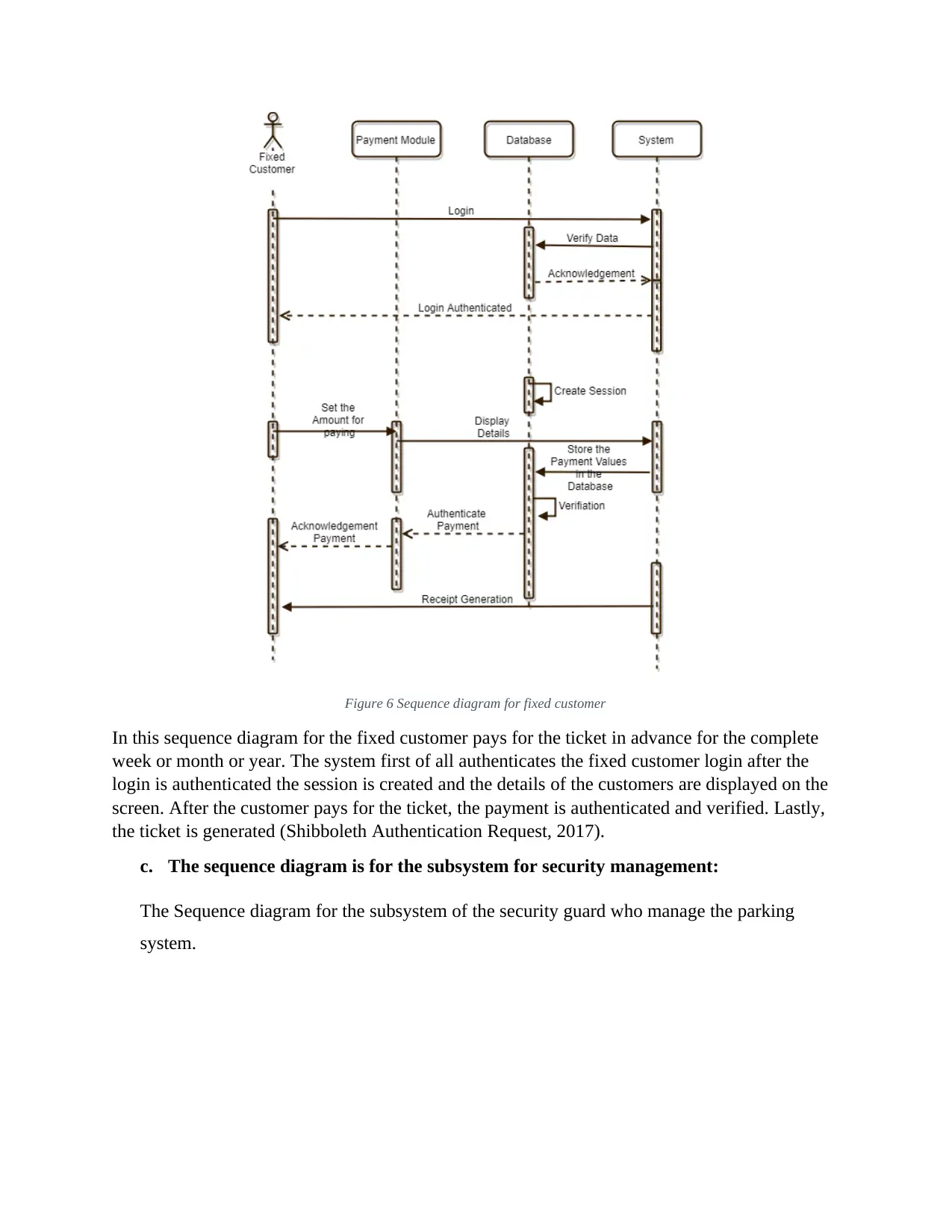
Figure 6 Sequence diagram for fixed customer
In this sequence diagram for the fixed customer pays for the ticket in advance for the complete
week or month or year. The system first of all authenticates the fixed customer login after the
login is authenticated the session is created and the details of the customers are displayed on the
screen. After the customer pays for the ticket, the payment is authenticated and verified. Lastly,
the ticket is generated (Shibboleth Authentication Request, 2017).
c. The sequence diagram is for the subsystem for security management:
The Sequence diagram for the subsystem of the security guard who manage the parking
system.
In this sequence diagram for the fixed customer pays for the ticket in advance for the complete
week or month or year. The system first of all authenticates the fixed customer login after the
login is authenticated the session is created and the details of the customers are displayed on the
screen. After the customer pays for the ticket, the payment is authenticated and verified. Lastly,
the ticket is generated (Shibboleth Authentication Request, 2017).
c. The sequence diagram is for the subsystem for security management:
The Sequence diagram for the subsystem of the security guard who manage the parking
system.
⊘ This is a preview!⊘
Do you want full access?
Subscribe today to unlock all pages.

Trusted by 1+ million students worldwide
1 out of 15
Related Documents
Your All-in-One AI-Powered Toolkit for Academic Success.
+13062052269
info@desklib.com
Available 24*7 on WhatsApp / Email
![[object Object]](/_next/static/media/star-bottom.7253800d.svg)
Unlock your academic potential
Copyright © 2020–2025 A2Z Services. All Rights Reserved. Developed and managed by ZUCOL.





